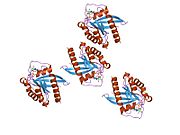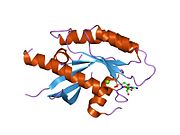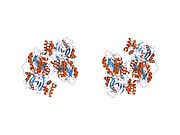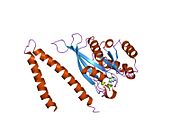RAB7A
Ras-related protein Rab-7ais aproteinthat in humans is encoded by theRAB7Agene.[5][6]
Ras-related protein Rab-7a is involved inendocytosis,which is a process that brings substances into a cell. The process of endocytosis works by folding thecell membranearound a substance outside of the cell (for example a protein) and then forms avesicle.The vesicle is then brought into the cell and cleaved from the cell membrane. RAB7A plays an important role in the movement of vesicles into the cell as well as with vesicle trafficking.[7]
Variousmutationsof RAB7A are associated withHereditary sensory neuropathy type 1C(HSN IC), also known asCharcot-Marie-Tooth syndrome type 2B(CMT2B).[8]
Function
[edit]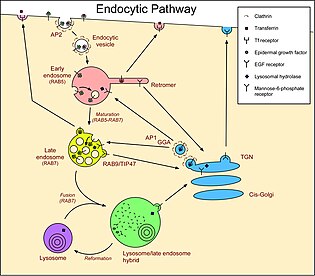
Members of theRABfamily of RAS-related GTP-binding proteins are important regulators of vesicular transport and are located in specific intracellular compartments. RAB7 has been localized to lateendosomesand shown to be important in the late endocytic pathway. In addition, it has been shown to have a fundamental role in the cellular vacuolation induced by thecytotoxinVacA ofHelicobacter pylori.[9]
RAB7A functions as a key regulator in endo-lysosomal trafficking, governs early-to-late endosomal maturation, microtubule minus-end as well as plus-end directed endosomal migration and positions, and endosome-lysosome transport through differentprotein-protein interactioncascades.
RAB7A is also involved in regulation of some specialized endosomalmembrane trafficking,such as maturation ofmelanosomesthrough modulation ofSOX10and the oncogeneMYC.Mutations in the lysosomal pathway result in tumor progression in melanoma cells.
Tissue distribution
[edit]RAB7 is widely expressed; high expression found in skeletal muscle[10]as it plays a role in the long-range retrograde transport of signallingendosomesin theaxons.
Gene
[edit]
TheRAB7Agene is located onchromosome 3in humans, specifically on the longq armfrombase pair128,726,135 to 128,814,797. The location was found usingmappingwhich was first done by Davies et al. in 1997 to map theRAB7Agene to chromosome 3 usingPCR analysis.[5]In 1995 it had been mapped to chromosome 9 in mice by Barbosa et al. Finally, usingfluorescence in situ hybridization(FISH), Kashuba et al. were able to map theRAB7Agene to 3q21 in 1997.[6]
RAB7a was cloned by screening a human placenta cDNA library with a rat Rab7 cDNA to show that the RAB7a cDNA encodes a 207-amino acid protein whose sequence is 99% identical to those of mouse, rat, and dog Rab7a and 61% identical to that of yeast Rab7a. UsingNorthern Blot Analysis,Vitelli et al. (1996) found that RAB7a wasexpressedas 1.7- and 2.5-kb transcripts in all cell lines examined but that there was a large difference in the total amount of RAB7a mRNA among the cell lines.[11]
Regulation
[edit]
It is linked that RAB7a levels and function were independent ofmelanocytelineage-specifictranscription factors(MITF) but recent research has shown thatSOX10(a neuroectodermal master modulator) and MYC (an oncogene) are the major regulators. Rab7a is regulated by SOX10 and MYC respectively in a lineage-specific wiring. Studies show that RAB7a can be specifically up regulated through MITF-independent manners like changing levels of SOX10 or MYC to affect tumor proliferation especially in melanoma[14].
In studies usingantisense RNA,downregulation of RAB7 gene expression inHeLacells using antisense RNA induces severe cell vacuolation that resembles thephenotypeseen infibroblastsfrom patients withChédiak–Higashi syndrome.[12]
In the presence ofgrowth factor,growth factorinhibition of mammalian Rab7 had no effect on nutrient transporter expression in mouse pro-B-lymphocytic cells. In growth factor-deprived cells, however, blocking Rab7 function prevented the clearance ofglucoseandamino acid transporterproteins from the cell surface. When Rab7 was inhibited, growth factor-deprived cells maintained their mitochondrial membrane potential and displayed prolonged, growth factor-independent, nutrient-dependent cell survival. The authors concluded that RAB7 functions as aproapoptoticprotein by limiting cell-autonomous nutrient uptake.[13]
Interactions
[edit]RAB7A has been shown tointeractwithRILP[14][15]andCHM.[16][17]RILP has been shown to have a key role in the control of transport to degradative compartments along with Rab7 and may link Rab7 function to thecytoskeleton.RILP plays the role of adownstream effectorfor Rab7 and together both of these proteins act toregulatelate endocytic traffic.[18]
RAB7A directly interacts withRubiconwhen RAB7A is bound to GTP. Rubicon is a negative regulator ofautophagy.[19]
Other key interactions includeRAC1(By similarity),NTRK1/TRKA(By similarity),C9orf72(By similarity),CHM(the substrate-binding subunit of the Rab geranylgeranyltransferase complex), and RILP,[20]as well asPSMA7,RNF115andFYCO1.Interacts with the PIK3C3/VPS34-PIK3R4 complex. The GTP-bound form interacts withOSBPL1AandCLN3.[21]Rab7A was also shown to interact with theRetromerComplex, most likely through theVps35subunit.[22]
Clinical significance
[edit]RAB7 is a smallGTPasethat has the potential of causingmalignancyfrom over 35 tumor types. It is found that RAB7 is an early induced melanoma driver whose levels can define metastatic risk. TheRAB7Agene belongs to the RAB family ofgenes,which is a member of the RASoncogenefamily. These genes in the RAB family provides the instructions that are necessary for making proteins for vesicle trafficking. These proteins are GTPases and act like a switch which is turned on and off byGTPandGDPmolecules.[7]
Melanoma
[edit]Melanoma cells retain a developmental memory that reflects a unique wiring of vesicles trafficking pathways. Rab7 is seen to control theproliferativeand invasive potential of these aggressive tumors upon identification of melanoma enriched endolysosomalgene cluster.Lysosomal-associated degradation, a universal feature ofeukaryotic cells,can be hijacked in a tumor-type- and stage –dependent manner. Finding that RAB7 is controlled by SOX10 and MYC in a MITF-independent manner has important basic and translational implications.[23]Sox10 is not inhibited by mechanisms thatdownregulateMITF, some of which includingBRAFmutations, are relatively frequent in malignant melanomas. This may ensure a developmental memory in the expression of RAB7. It is speculated that downregulation of RAB7 in the invasive front of aggressive melanomas is modulated by epithelial-to-mesenchymal-like mechanisms, such as those recently described to underlie the transcriptional switch associated with prometastatic phenotypes. In otherwords, there is an inherent dependency of melanoma cells on the small GTPase RAB7, identified within a lysosomal gene cluster that distinguishes this malignancy from over 35 tumor types. Analyses in human cells, clinical specimens, and mouse models demonstrated that RAB7 is an early-induced melanoma driver whose levels can be tuned to favor tumor invasion, ultimately defining metastatic risk. Importantly, RAB7 levels and function were independent of MITF and instead, the neuroectodermal master modulator SOX10 and the oncogene MYC are key RAB7a regulators.[23]
Charcot-Marie-Tooth 2B
[edit]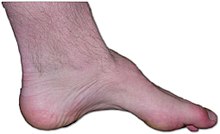
Also known as Charcot–Marie–Tooth neuropathy, hereditary motor and sensory neuropathy (HMSN) and peroneal muscular atrophy (PMA). This is a genetically and clinically heterogeneous group ofinheriteddisorders, characterized by prominent sensory loss, often complicated by severe ulcero-mutilations of toes or feet, and variable motor involvement.[24][25]Missense mutationsin RAB7A, the gene encoding the small GTPase Rab7, cause CMT2B and increase Rab7 activity. Rab7 is ubiquitously expressed and is involved in degradation through the lysosomal pathway. Currently incurable, this disease is one of the most common inherited neurological disorders affecting approximately 1 in 2,500 people equating to approximately 23,000 people in the United Kingdom and 125,000 people in the United States. CMT was previously classified as a subtype ofmuscular dystrophy.[26]
References
[edit]- ^abcGRCh38: Ensembl release 89: ENSG00000075785–Ensembl,May 2017
- ^abcGRCm38: Ensembl release 89: ENSMUSG00000079477–Ensembl,May 2017
- ^"Human PubMed Reference:".National Center for Biotechnology Information, U.S. National Library of Medicine.
- ^"Mouse PubMed Reference:".National Center for Biotechnology Information, U.S. National Library of Medicine.
- ^abDavies JP, Cotter PD, Ioannou YA (Apr 1997). "Cloning and mapping of human Rab7 and Rab9 cDNA sequences and identification of a Rab9 pseudogene".Genomics.41(1): 131–4.doi:10.1006/geno.1997.4644.PMID9126495.
- ^abKashuba VI, Gizatullin RZ, Protopopov AI, Allikmets R, Korolev S, Li J, Boldog F, Tory K, Zabarovska V, Marcsek Z, Sumegi J, Klein G, Zabarovsky ER, Kisselev L (Dec 1997). "NotI linking/jumping clones of human chromosome 3: mapping of the TFRC, RAB7 and HAUSP genes to regions rearranged in leukemia and deleted in solid tumors".FEBS Letters.419(2–3): 181–5.doi:10.1016/S0014-5793(97)01449-X.PMID9428630.S2CID10164824.
- ^ab"RAB7A Genetics Home Reference".U.S. National Library of Medicine.Archived fromthe originalon 27 June 2020.Retrieved21 October2014.
- ^Auer-Grumbach M (March 2008)."Hereditary sensory neuropathy type I".Orphanet Journal of Rare Diseases.3(7): 7.doi:10.1186/1750-1172-3-7.PMC2311280.PMID18348718.
- ^"Entrez Gene: RAB7A RAB7A, member RAS oncogene family".
- ^Verhoeven K, De Jonghe P, Coen K, Verpoorten N, Auer-Grumbach M, Kwon JM, FitzPatrick D, Schmedding E, De Vriendt E, Jacobs A, Van Gerwen V, Wagner K, Hartung HP, Timmerman V (Mar 2003)."Mutations in the small GTP-ase late endosomal protein RAB7 cause Charcot-Marie-Tooth type 2B neuropathy".American Journal of Human Genetics.72(3): 722–727.doi:10.1086/367847.PMC1180247.PMID12545426.
- ^Vitelli R, Chiariello M, Lattero D, Bruni CB, Bucci C (Dec 1996). "Molecular cloning and expression analysis of the human Rab7 GTP-ase complementary deoxyribonucleic acid".Biochemical and Biophysical Research Communications.229(3): 887–890.doi:10.1006/bbrc.1996.1897.PMID8954989.
- ^Davies JP, Cotter PD, Ioannou YA (Apr 1997). "Cloning and mapping of human Rab7 and Rab9 cDNA sequences and identification of a Rab9 pseudogene".Genomics.41(1): 131–134.doi:10.1006/geno.1997.4644.PMID9126495.
- ^Edinger AL, Cinalli RM, Thompson CB (Oct 2003)."Rab7 prevents growth factor-independent survival by inhibiting cell-autonomous nutrient transporter expression".Developmental Cell.5(4): 571–82.doi:10.1016/s1534-5807(03)00291-0.PMID14536059.
- ^Cantalupo G, Alifano P, Roberti V, Bruni CB, Bucci C (Feb 2001)."Rab-interacting lysosomal protein (RILP): the Rab7 effector required for transport to lysosomes".The EMBO Journal.20(4): 683–93.doi:10.1093/emboj/20.4.683.PMC145419.PMID11179213.
- ^Caplan S, Hartnell LM, Aguilar RC, Naslavsky N, Bonifacino JS (Jul 2001)."Human Vam6p promotes lysosome clustering and fusion in vivo".The Journal of Cell Biology.154(1): 109–22.doi:10.1083/jcb.200102142.PMC2196876.PMID11448994.
- ^Rak A, Pylypenko O, Niculae A, Goody RS, Alexandrov K (Jan 2003). "Crystallization and preliminary X-ray diffraction analysis of monoprenylated Rab7 GTPase in complex with Rab escort protein 1".Journal of Structural Biology.141(1): 93–5.doi:10.1016/S1047-8477(02)00634-2.PMID12576024.
- ^Alexandrov K, Simon I, Iakovenko A, Holz B, Goody RS, Scheidig AJ (Apr 1998)."Moderate discrimination of REP-1 between Rab7 x GDP and Rab7 x GTP arises from a difference of an order of magnitude in dissociation rates".FEBS Letters.425(3): 460–4.doi:10.1016/S0014-5793(98)00290-7.PMID9563513.S2CID39125409.
- ^Wu M, Wang T, Loh E, Hong W, Song H (Apr 2005)."Structural basis for recruitment of RILP by small GTPase Rab7".The EMBO Journal.24(8): 1491–1501.doi:10.1038/sj.emboj.7600643.PMC1142575.PMID15933719.
- ^Bhargava, Hersh K.; Tabata, Keisuke; Byck, Jordan M.; Hamasaki, Maho; Farrell, Daniel P.; Anishchenko, Ivan; DiMaio, Frank; Im, Young Jun; Yoshimori, Tamotsu; Hurley, James H. (2020-07-21)."Structural basis for autophagy inhibition by the human Rubicon-Rab7 complex".Proceedings of the National Academy of Sciences of the United States of America.117(29): 17003–17010.Bibcode:2020PNAS..11717003B.doi:10.1073/pnas.2008030117.ISSN1091-6490.PMC7382272.PMID32632011.
- ^Wang T, Wong KK, Hong W (Feb 2004)."A unique region of RILP distinguishes it from its related proteins in its regulation of lysosomal morphology and interaction with Rab7 and Rab34".Molecular Biology of the Cell.15(2): 815–826.doi:10.1091/mbc.E03-06-0413.PMC329395.PMID14668488.
- ^Uusi-Rauva K, Kyttälä A, van der Kant R, Vesa J, Tanhuanpää K, Neefjes J, Olkkonen VM, Jalanko A (Jun 2012)."Neuronal ceroid lipofuscinosis protein CLN3 interacts with motor proteins and modifies location of late endosomal compartments".Cellular and Molecular Life Sciences.69(12): 2075–2089.doi:10.1007/s00018-011-0913-1.PMC11114557.PMID22261744.S2CID5733226.
- ^Rojas R, van Vlijmen T, Mardones GA, Prabhu Y, Rojas AL, Mohammed S, Heck AJ, Raposo G, van der Sluijs P, Bonifacino JS (Nov 2008)."Regulation of retromer recruitment to endosomes by sequential action of Rab5 and Rab7".The Journal of Cell Biology.183(3): 513–26.doi:10.1083/jcb.200804048.PMC2575791.PMID18981234.
- ^abAlonso-Curbelo D, Riveiro-Falkenbach E, Pérez-Guijarro E, Cifdaloz M, Karras P, Osterloh L, Megías D, Cañón E, Calvo TG, Olmeda D, Gómez-López G, Graña O, Sánchez-Arévalo Lobo VJ, Pisano DG, Wang HW, Ortiz-Romero P, Tormo D, Hoek K, Rodríguez-Peralto JL, Joyce JA, Soengas MS (Jul 2014)."RAB7 controls melanoma progression by exploiting a lineage-specific wiring of the endolysosomal pathway".Cancer Cell.26(1): 61–76.doi:10.1016/j.ccr.2014.04.030.PMID24981740.
- ^"Physical Medicine and Rehabilitation for Charcot-Marie-Tooth Disease".Medscape.Retrieved4 November2014.
- ^Krajewski KM, Lewis RA, Fuerst DR, Turansky C, Hinderer SR, Garbern J, Kamholz J, Shy ME (Jul 2000). "Neurological dysfunction and axonal degeneration in Charcot-Marie-Tooth disease type 1A".Brain.123(7): 1516–27.doi:10.1093/brain/123.7.1516.PMID10869062.
- ^Janssens K, Goethals S, Atkinson D, Ermanoska B, Fransen E, Jordanova A, Auer-Grumbach M, Asselbergh B, Timmerman V (May 2014). "Human Rab7 mutation mimics features of Charcot-Marie-Tooth neuropathy type 2B in Drosophila".Neurobiology of Disease.65:211–9.doi:10.1016/j.nbd.2014.01.021.PMID24521780.S2CID140204654.







